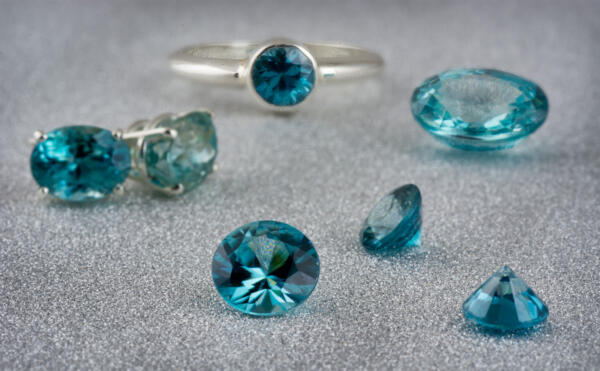Gem in the Spotlight: Blue Zircon
The Colored Gemstone with Sparkle
Zircon may be last in the alphabet of gemstones, but it is first in sparkle. The crystal structure of zircon creates one of the liveliest displays found in any colored gem. In fact, before any of the manmade diamond simulates were made, the colorless version of zircon was used in jewelry to mimic diamond. Why? Natural zircon is known for its scintillation, brilliance, and flashes of color or fire just like diamond.
Zircon also is known for its variety of colors. Blue zircon is the most popular color. But, zircon can be almost any color you can imagine including red, yellow, orange, brown, green, champagne, golden, saffron, and colorless. Zircon colors are pure and have that distinctive fire that sets it apart from other gems.
The Gemology of Zircon
Why does zircon have so much more fire then other colored gems? Zircon has a high refractive index (1.92-2.01). The refractive index (abbreviated RI) of a gemstone is its optical property that refers to the ratio of the speed of light in a vacuum to the speed of light through a transparent gem. Light is bent as it moves from air to the gem material. This process breaks light into its spectral hues like a rainbow. Then the rainbow effect is broken and focused by the facets of the gem to create the brilliant light show we see.
Zircon is also of interest to geologists because it is one of the oldest minerals on earth.
In the gem world, a type of stone is often given different names for each of its colors, and Zircon is no exception. Here are examples of a few of them. Jacinth or Hyacinth refers to the yellow, orange, brown, or red variety of Zircon. Jargon is the colorless, pale gray, or pale yellow variety of Zircon. Matura Diamond is another trade name for colorless Zircon. Starlite is the name for the blue gem variety of Zircon. The color of Starlite is rarely natural, and is almost always heat treated. Of course, the blue form of Zircon is also called, imaginatively, Blue Zircon.
Blue zircon was a specific favorite in Victorian times, when fine gems were often featured in English estate jewelry dating from the 1880s. Tiffany’s famous gemologist George Kunz was a distinguished zircon advocate. He proposed the name “starlite” to promote the gem’s fiery nature. Unfortunately, the name never caught on, and today we use the simpler term, Blue Zircon.
Zircon is commonly heat treated. Brown zircons can be transformed into colorless or blue zircons through heat treatments. Zircon is a durable gemstone with good hardness on the Mohs scale (6 to 7.5). However, Zircon has what is known as indistinct cleavage which creates a somewhat brittle tendency that can lead to chips, especially along facet edges requiring extra care when setting, cleaning, or wearing.
The Mythology and History of Zircon
Since it has been known from antiquity, Zircon has a rich mythology. Zircon is one of December’s birthstones. In the middle ages, Zircon was said to aid in resting, induce sound sleep, drive away evil spirits, bring prosperity, and promote honor and wisdom in its owner. Zircon is assigned to the planet Pluto and is said to be of help for varicose veins, blisters, and even testicular problems. According to some, Zircon relieves pain and is said to prevent nightmares, ensuring a deep, tranquil sleep. Beyond all of this, Zircon is believed to bestow the wearer with wisdom, honor, and riches. But beware, the loss of luster on a Zircon stone is said to warn of danger.
Zircon is also of interest to geologists because it is one of the oldest minerals on earth. Some zircon specimens from Australia date at 4.4 million years old. Considering that scientists currently estimate that the earth formed around 4.56 billion years ago, that makes Zircon one of the earliest known gems.
The Care and Cleaning of Zircon
Zircon care and cleaning is simple: avoid steamers or ultrasonic cleaners. This is particularly important with stones that may have been color enhanced (like most Blue Zircon). Also, avoid the use of harsh cleaning chemicals or agents, especially bleach and acid. Clean the gem using a soft cloth or brush and a mild soap or detergent if needed. Rinse zircon with warm or room-temperature water to remove soapy residue. Zircon is hard but brittle and can fracture or chip along faceted edges. Treat your zircon with care and it can sparkle for many years and even be passed down through the generations.
Final Thoughts
Zircon has one major problem not of its own making. It is often confused with Cubic Zirconia, a synthetic diamond simulant. Cubic Zirconia, also known as CZ, is even incorrectly shortened to zircon by some. The situation is made even more confusing by the fact that in the past, zircon, like CZ, was also used as a diamond simulant. This only adds to the wrong perception about zircon. Zircon is a natural gemstone with amazing characteristics which is not to be confused with cheap, manmade Cubic Zirconia.
Zircon is a remarkable gemstone with wonderful colors and brilliant flashes of light. To top it all off, zircon is generally very affordable. It is a wonderful gemstone for jewelry wearers and gem collectors alike. Plus, it out sparkles the other December birthstones (Blue Topaz and Tanzanite) making it a great gift for anyone born in December or who simply appreciates dazzling, fiery gems.
